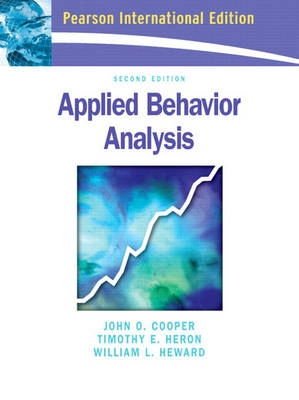PART I. INTRODUCTION AND BASIC CONCEPTS
Chapter 1 Definition and Characteristics of Applied Behavior Analysis
Chapter 2 Basic Concepts
PART II. SELECTING, DEFINING, AND MEASURING BEHAVIOR
Chapter 3 Selecting and Defining Target Behaviors
Chapter 4 Measuring Behavior
Chapter 5 Improving and Assessing the Quality of Behavioral Measurement
PART III. EVALUATING AND ANALYZING BEHAVIOR CHANGE
Chapter 6 Constructing and Interpreting Graphic Displays
Chapter 7 Analyzing Behavior Change: Basic Assumptions and Strategies
Chapter 8 Analytic Tactics Using Withdrawal, Reversal, and Multi-Element Treatment Conditions
Chapter 9 Analytic Tactics Using Multiple Baselines and Changing Criteria
Chapter 10 Planning, Conducting, and Evaluating Research in Applied Behavior Analysis
PART IV. REINFORCEMENT
Chapter 11 Positive Reinforcement
Chapter 12 Negative Reinforcement - Brian A. Iwata and Richard G. Smith
Chapter 13 Schedules of Reinforcement
PART V. PUNISHMENT
Chapter 14 Punishment by Presentation of a Stimulus
Chapter 15 Punishment by Removal of a Stimulus
PART VI. ANTECEDENT VARIABLES
Chapter 16 Motivating Operations - Jack L. Michael
Chapter 17 Stimulus Control
PART VII. DEVELOPING NEW BEHAVIOR
Chapter 18 Imitation
Chapter 19 Shaping
Chapter 20 Chaining
PART VIII. DECREASING BEHAVIOR WITH Nonpunishment procedures
Chapter 21 Extinction
Chapter 22 Differential Reinforcement
Chapter 23 Antecedent Interventions
PART IX. FUNCTIONAL ANALYSIS
Chapter 24 Functional Behavior Assessment — Nancy A. Neef and Stephanie M. Peterson
PART X. VERBAL BEHAVIOR
Chapter 25 Verbal Behavior - Mark Sundberg
PART XI. SPECIAL APPLICATIONS
Chapter 26 Contingency Contracting, Token Economy, and Group Contingencies
Chapter 27 Self-Management
PART XII. PROMOTING GENERALIZED BEHAVIOR CHANGE
Chapter 28 Generalization and Maintenance of Behavior Change
PART XIII. ETHICS
Chapter 29 Ethical Considerations for Applied Behavior Analysts - Jose A. Martinez-Diaz, Thomas Freeman, and Matthew Normand
Åtkomstkoder och digitalt tilläggsmaterial garanteras inte med begagnade böcker





















